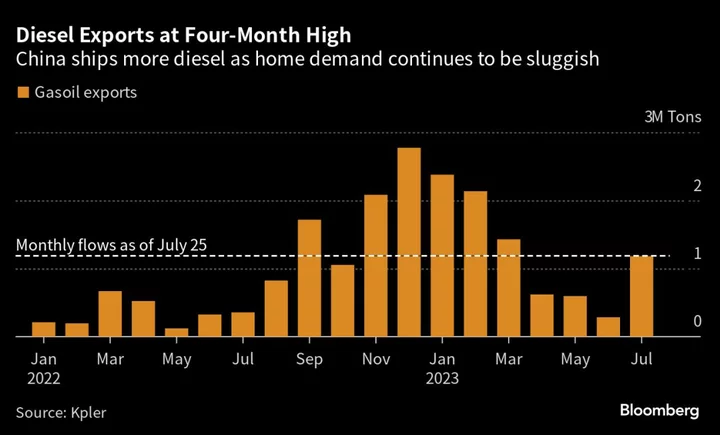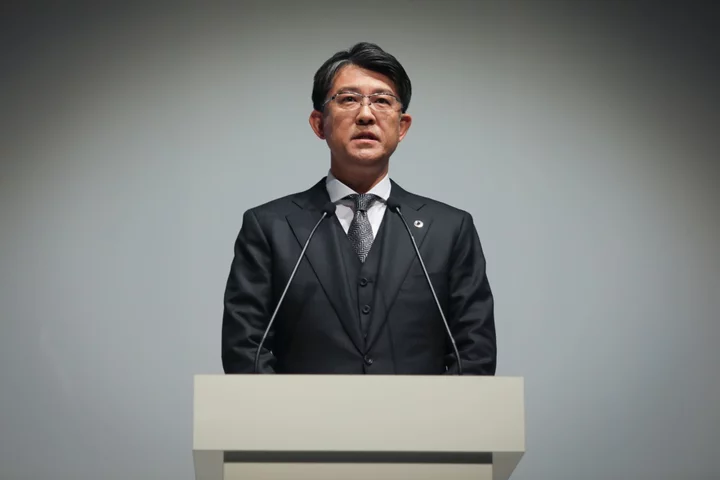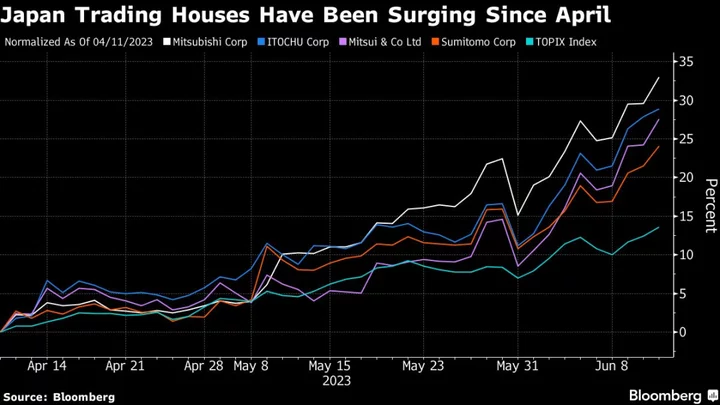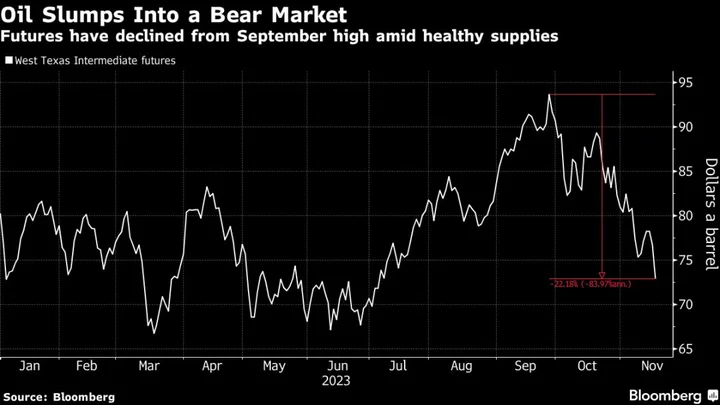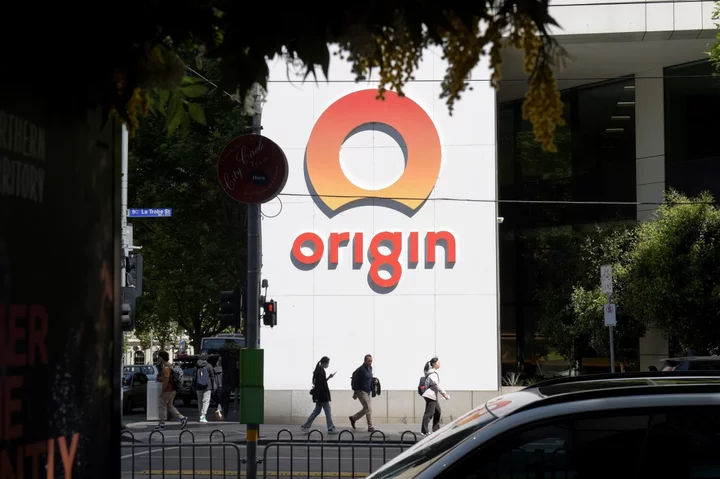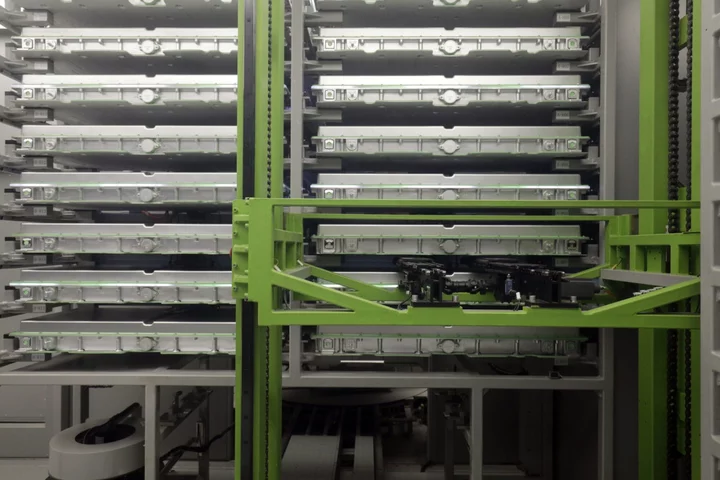China’s appetite for fuels and other oil-derived products such as plastics may have peaked for this year as the nation’s economic woes continue to stand in the way of a full rebound from Covid Zero.
While recent headline numbers for crude imports pointed to robust oil demand, much of that supply has been stockpiled rather than turned into gasoline and diesel, according to analysts. The nation’s economic recovery continues to show signs of strain this year through weak indicators across manufacturing and infrastructure sectors, weighing on the outlook for commodities.
Oil bulls have already revised their expectations on China’s outlook, but further economic hurdles could cap crude’s price gains, even as the market tightens on supply cuts by key OPEC+ members. Industry consultant Mysteel OilChem says diesel and gasoline consumption is unlikely to reach pre-pandemic levels this year, and electric vehicles are presenting a challenge to future demand.
“There is not much room for growth left in the second half,” said Mia Geng, an analyst with FGE, referring to China. The industry consultant expects Chinese oil demand growth will slow to 1.1 million barrels a day over the final six months of the year, compared with 1.3 million barrels a day in the first half.
Read More: Citigroup’s Ed Morse Warns Oil Bulls Are Wrong to Jump In Now
While the post-Covid-19 recovery has disappointed, China’s oil demand is still expected to climb in coming years before peaking in 2030. However, headwinds still remain for energy consumption in the short term.
Diesel Lull
China’s oil demand this year likely peaked at 16.4 million barrels a day in the second quarter, said Jianan Sun, an analyst with Energy Aspects Ltd. It’s expected to ease to 15.8 million barrels a day in the third quarter before rising in the final three months to about 16.2 million barrels a day.
For 2024, Energy Aspects expects demand will remain above 16 million barrels a day, reaching almost 17 million barrels a day in the second quarter.
The current demand weakness is evident in diesel, a key industrial fuel used in the mining, logistics and agriculture sectors. The nation has ramped up exports and added to commercial stockpiles as domestic consumption wanes, according to data intelligence firm Kpler and OilChem.
Monthly overseas shipments were at 1.19 million tons as of July 25, the highest level since March, according to preliminary data from Kpler, while OilChem estimates commercial inventories were at a three-month high as of July 20.
Read More: Diesel Exports Flood Out of China on Demand Lull, Good Margins
China’s imports of crude exceeded 12 million barrels a day in May and reached a three-year high in June, prompting bullish optimism in the nation’s outlook. However, a lot of that oil has been stockpiled as buyers took advantage of lower prices to replenish inventories and demand disappointed.
Beijing doesn’t publicly disclose the size of the nation’s crude inventories but Vortexa Ltd. estimates onshore stockpiles have expanded to a record 1.02 billion barrels. That compares with the US strategic reserve, which currently holds almost 347 million barrels after a series of drawdowns.
Crude processing is pointing to a mixed picture. Operating rates for state-run refiners were just over 80% of capacity as of July 27, ten percentage points higher than same period last year, but rates for the nation’s independent processors were down from a year earlier, near 60% of capacity.
The possibility of meaningful stimulus by Beijing this year looms, which would propel oil prices higher. The government has so far stopped short of providing direct fiscal support to consumers and companies to increase spending.
Congestion levels in top Chinese cities are easing and the rapid adoption of electric vehicles is posing a challenge to gasoline consumption. Beijing recently introduced measures to boost purchases of so-called new-energy vehicles.
Sales of NEVs — electric vehicles and plug-in hybrids — climbed 37% to 3.1 million units in the first half of the year compared with the same period in 2022, while internal combustion engine car sales slid 8%. Both gasoline and diesel consumption will reach about 95% pre-pandemic levels this year, according to Liu Bingjuan, an analyst with OilChem.
“For the second half, it seems there’s not much meaningful demand growth on the gasoline and diesel consumption front,” Guo Chaohui, an analyst at Beijing-based China International Capital Corp. However, crude imports may remain robust if refiners continue to restock, he added.
The Week’s Diary
(All times Beijing unless noted.)
Wednesday, Aug. 2:
- Greenpeace online seminar on China-EU clean energy investment, 09:30
- CCTD’s weekly online briefing on Chinese coal, 15:00
- EARNINGS: Power Assets
Thursday, Aug. 3:
- Caixin China services & composite PMIs, 09:45
- China Petroleum and Chemical Industry Economic Situation Analysis Conference in Zhengzhou, day 1
Friday, Aug. 4:
- China weekly iron ore port stockpiles
- Shanghai exchange weekly commodities inventory, ~15:30
- China Petroleum and Chemical Industry Economic Situation Analysis Conference in Zhengzhou, day 2
On the Wire
Parts of northern China are grappling with the impact of intense flooding as the death toll rose to 20 following days of torrential rain in the wake of Typhoon Doksuri.
--With assistance from Jason Rogers.
(Updates with diary items in 2nd section)

